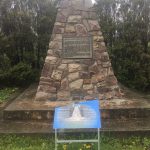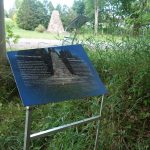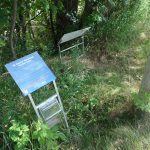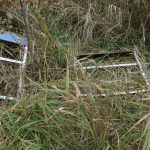Counter Monument
2018
Sculpture / Site-specific Installation
Collaboration with Bruce Anderson
Curated by Kate Ward
Commissioned by Uncommon Common Art projects, 2018
Featured in Canadian Art Magazine
Counter-monuments are counterpoints to existing memorials. The intention is to open space for a discussion about how to more adequately remember and memorialize The Expulsion of the Acadians/La Grande Dérangement.
There are three locations, listed below. At each location there is a sign similar to the typical tourist interpretative signs. Each sign is comprised of an image of the existing memorial at that particular location plus a text overlaid/printed on top of the image. Each sign is situated facing the existing memorial. The intention is not to block or dominate the existing monument but to offer a counterpoint through another historical text. The size of each sign befits the site, approximately 2×2 feet or 2×3 feet.
The interpretive signs are made by Paul Cooper at A-Line Screenprinting Ltd. and are installed with consideration to the sites’ safety requirements. A-Line Screenprinting Ltd. is also the service provider that makes all of Nova Scotia’s interpretive signage.
1. Starr’s Point – Planters’ Cairn 1983
Current text on the monument:
Following the expulsion of the Acadians in 1755, these fertile lands lay empty. In response to an invitation from Nova Scotia, New England settlers, known as Planters, landed on this site on June 4, 1760.
This natural landing place was known to the Acadians as Boudreau’s Bank on the Grand Habitant River. The Planters designated a town site area to be known as Town Plot. Although the name still remains the town was never developed and the river and district were renamed Cornwallis. From here a public ferry linked the two townships of Cornwallis and Horton.
Today these historic lands are one of the most fruitful agricultural areas in Canada. Descendants of the Planters who make their home here are proud of their heritage.
The text on our sign:
“We are now upon a great and noble Scheme of sending the neutral French out of this Province, who have always been the Secret Enemies, and have encouraged our Savages to cut our throats. If we effect their Expulsion, it will be one of the greatest things that ever the English did in America, for by all Accounts, that Part of the Country they possess, is as good land as any in the World: In case therefore we could get some good English Farmers in their Room, this Province would abound with all Kinds of Provisions.”
(quoted by J. Faragher, A Great and Noble Scheme, 2005, 333) from: Pennsylvania Gazette, 4 September 1755; New York Gazette, 25 August 1755; Maryland Gazette, 18 September 1755.
2. French Cross Morden
Current text on the monument:
Tradition has it that on this site Acadians from Belle Isle wintered in 1755-56.
In the spring of 1756 Pierre Melanson with and Indian Boy crossed the bay for aid.
On the return trip he died.
The text on our sign:
“The Acadian entry in the book of the dead is staggering: in July 1755 they numbered some eighteen thousand persons in the maritime region. Over the next eight years an estimated ten thousand exiles and refugees lost their lives as a direct result of the campaign of expulsion.”
(J. Faragher, A Great and Noble Scheme, 2005, 470)
3. Longfellow 1807-1882 Monument
Current text on the monument:
Evangeline’s poignant tale of the Acadian lovers of Grand Pre has enshrined in the hearts of the world the tragic memory of the expulsion two Centuries ago.
The text for our sign:
“The material interest of Winslow and his troops in the expulsion of the Acadians was a culmination of the critical role played by New Englanders in the history of l’Acadie. The project was conceived and expedited by Governor William Shirley of Massachusetts, the legal justification provided by Chief Justice Jonathan Belcher, son of Shirley’s predecessor as governor, the operational plan written by Surveyor-General Charles Morris, Shirley’s protégé, the decision made by a council that had always been dominated by men hailing from Massachusetts. The Acadians were to be transported to distant destinations in New England vessels hired by one of the most important trading houses in Boston. They were to be forced from their homes by troops and officers from New England, and it was expected that those very men would repossess and resettle the land. It was a thoroughly Yankee operation.”
(from J. Faragher, A Great and Noble Scheme, 2005, 333)



